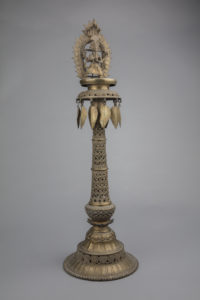
This magnificent Nepalese bronze statue depicts Ganesh, the Hindu god of wisdom, success, and good luck. Some of Ganesh’s telltale attributes include many arms, a rat shown at his feet, and an elephant head—all of which the oil lamp possesses. The figure sits behind a small receptacle in which ghee (yak butter) is poured to fuel the lamp. When ignited, the light is thought to be divine. Hindu worshippers believe that by lighting this lamp, peace and prosperity will be brought into their lives. Based on its placement, it is apparent that the figure and the scene it depicts holds great cultural significance to its people.
When thinking of private and public spheres of the home, we can think critically about how this lamp may more readily “fit” into one of these areas versus the other. It is interesting to think about how it might not strictly belong to either of these spheres. In Nepalese culture, lamps are commonly used to celebrate festivals in public settings, though a lamp with a significant religious purpose like this one might also be found in sacred temples and represent more private rituals.
